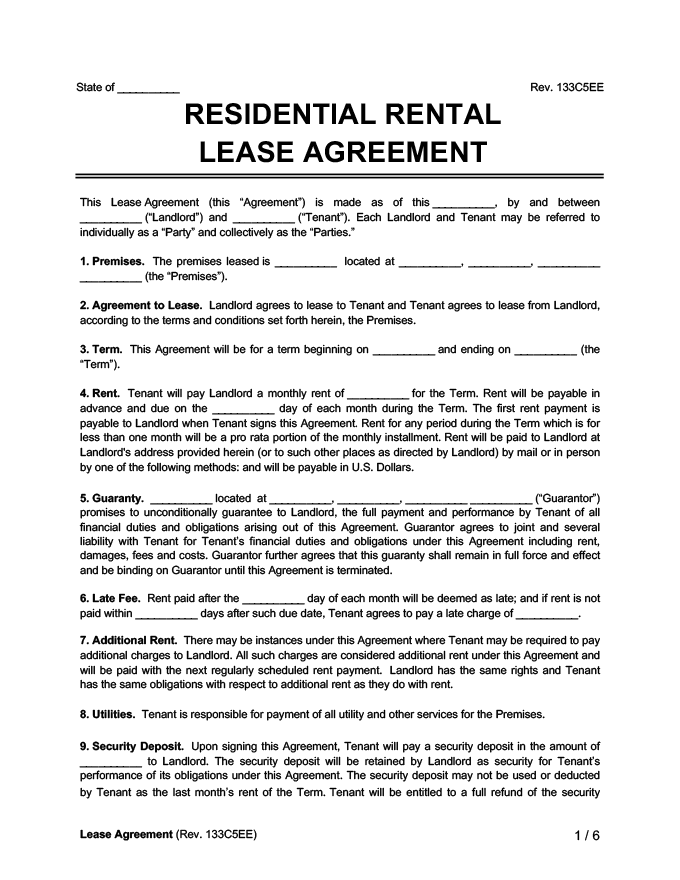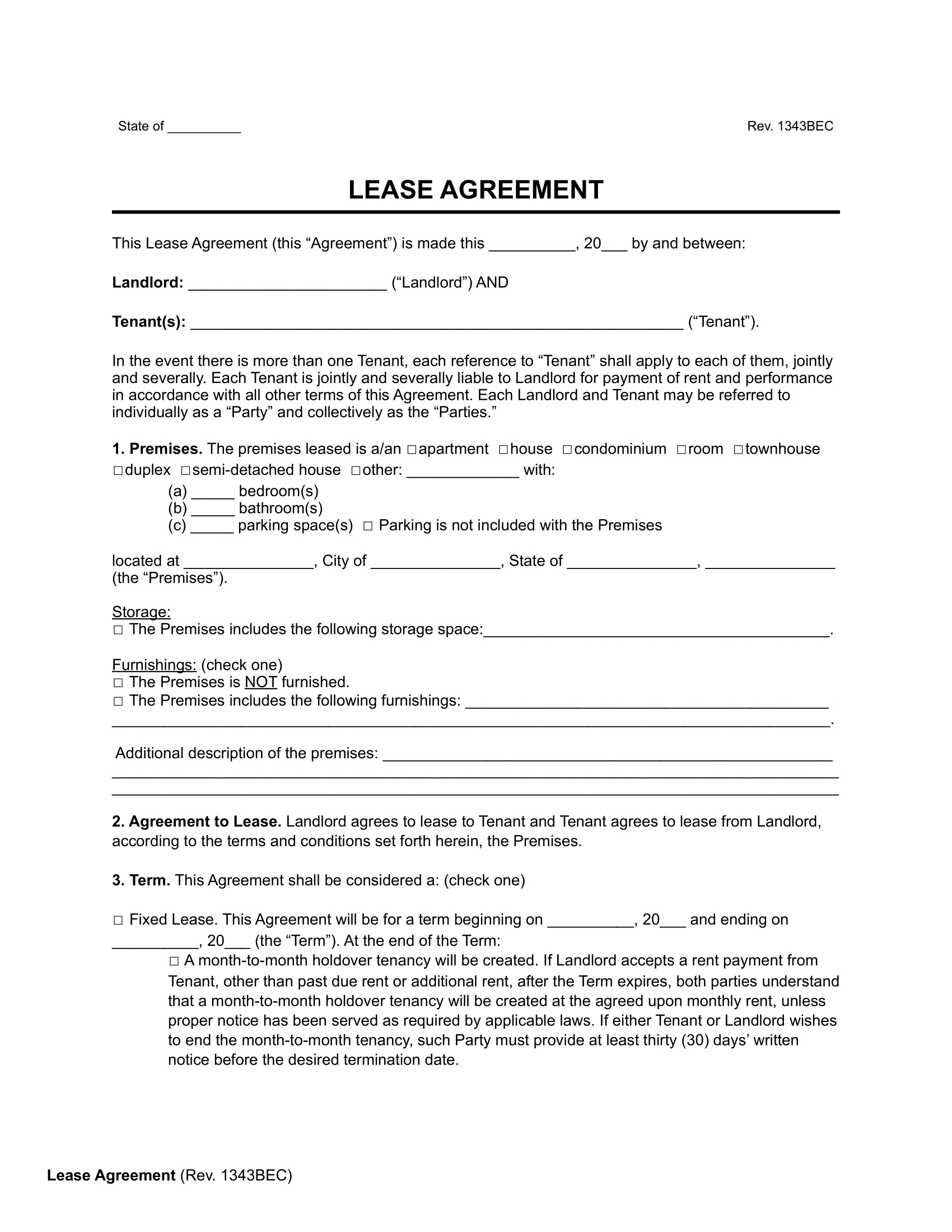-
1
Choose a form
Browse and select the document you need
-
2
Answer Questions
Go through our builder and complete your form in 5 minutes
-
3
Download & E-sign
Receive your document in PDF or Word format
 Create Document
Create Document
- Download as PDF and Word
- Access from desktop, tablet & mobile
- E-signature
- Yearly Updates & Notifications
A Lease Agreement is a contract between a landlord and tenant to rent a property.
Its purpose is to explain the landlord and tenant’s rights and obligations. Such an agreement is necessary for legal disputes to arise, which will cost you both time and money.
Use our Lease Agreement Form to build your rental property contract.
What Is a Lease Agreement?
A lease agreement is a contract to rent residential or commercial property. It is legally binding on the landlord and tenant and establishes the terms and conditions for the landlord-tenant relationship.
Lease agreements list the duties and rights of landlords and tenants.
Why Do You Need a Lease Agreement?
A lease agreement provides a reference point for all aspects of the landlord-tenant relationship. This reference spells out the tenant’s rights and duties and yours as the landlord.
Further, property renting can implicate federal, state, and local laws, which may complicate matters. A lease agreement helps all parties enjoy a smooth process should a dispute arise.
When Do You Use a Lease Agreement?
Use a lease agreement when someone lives at your property for a fixed period. When a lease agreement is for one year or longer, legally, the agreement must be in writing.
Practically, a lease agreement should always be in writing to avoid confusion on the rental relationship’s terms.
What to Include in a Lease Agreement
The terms of the lease agreement vary by state law. But there is some general information every agreement has:
- Names of the landlord and tenants
- Address of the property
- Rental price
- Length of the lease
- Utility information (who pays)
- Landlord’s rights and duties
- Tenant’s rights and duties
- Consequences of a breach
- Misc. information (a sublet or assignment form, pets, option for renewal, etc.)
How to Optimize a Lease and Maximize Rental Income
As a landlord, there are several ways to maximize your rental income. The following are popular examples:
- Furnish your property. Furnished properties can have higher rental prices because they offer the property ready for move-in. These types of rentals are popular with young professionals leasing their first property.
- Do your research. Always ensure you know the trends in rental prices in your neighborhood. This clarifies you are not offering your property for too much or too little.
- Maintain your property. Periodically do routine maintenance on your property to ensure everything (like appliances and utilities) is functioning efficiently. This helps you avoid costly repairs.
- Go green. Try to use modern and energy-efficient appliances. This is attractive to prospective tenants as the world is becoming more conscious of protecting the environment. When tenants use less energy, utility bills are lower.
- Put everything in the lease. Ensure you write all the terms and conditions of the lease agreement into the lease. This helps avoid any disputes and costly legal battles.
- Know your tenant. Always do a credit check and background check on any prospective tenants. This helps you understand whether or not the prospective tenant has the financial ability to abide by the lease throughout its duration.
- Insurance. Make it clear in the lease who is responsible for any damage. The tenant should have insurance for their belongings, but for the property itself, ensure either you or the tenant have home insurance.
How to Write a Lease Agreement
Follow the steps below to write a lease agreement.
Step 1 – Write Landlord and Tenant Names
Fill in the names of the landlord and tenant(s).
Step 2 – Note the Premises
Enter the complete property address.
Step 3 – Enter the Lease Term
Write the length of the lease.
Step 4 – Describe Rent Details
Note the rent amount and other rent details.
Step 5 – Write Guaranty Information
Enter any details regarding a guaranty for this lease.
Step 6 – Include Any Late Fees
Note whether or not there is a late fee and, if so, the amount.
Step 7 – Provide Utilities Details
Enter any requirements and information regarding utilities.
Step 8 – Specify Security Deposit
Note the amount for a security deposit.
Step 9 – State Use of Premises
Describe how the tenant may use the premises.
Step 10 – Note the Condition of the Premises
Outline the current condition of the rental unit.
Step 11 – Describe Maintenance and Repairs
Note how the landlord and tenant shall handle maintenance and repair issues.
Step 12 – Note Rules and Regulations Option
Write any specific rules the tenant must follow.
Step 13 – Choose the Military Clause Option
Select a military clause option.
Step 14 – Enter the Smoking Option
Choose a smoking option.
Step 15 – Note Pet Option
Outline your preference regarding pets.
Step 16 – Choose Inspection Checklist Option
Note whether or not the tenant must complete a property inspection checklist.
Step 17 – Enter Renter’s Insurance Option
Choose whether or not the tenant must obtain renter’s insurance.
Step 18 – Note Assignment and Subletting Option
Indicate whether or not the lease is assignable and if the lease or sublet.
Step 19 – Enter Default Details
Write what happens in the case of default.
Step 20 – Note Lead Disclosure Option
Indicate whether or not the property was built before 1978 and therefore needs a lead disclosure.
Step 21 – Write Notices Information
Describe where to send notices related to the lease.
Step 22 – Provide Governing Law State
Choose the state law that governs this lease.
Step 23 – Fill In Disputes Details
Note what happens in the case of a contract dispute.
Step 24 – Write Miscellaneous Terms and Information
Fill in miscellaneous terms and information regarding this lease.
